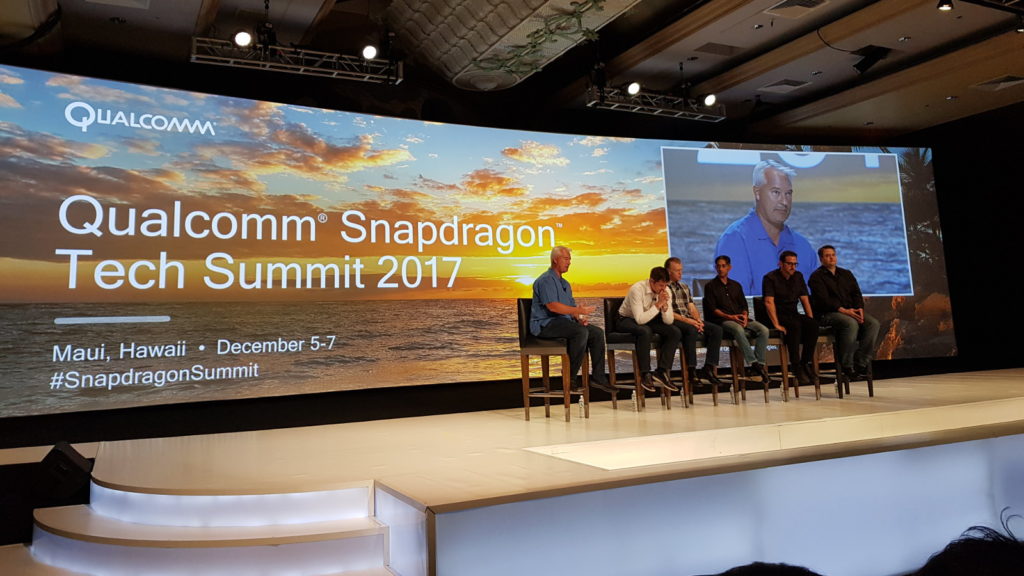Side hustles are no longer optional in South Africa. With food inflation still above 8 percent and electricity, transport and mobile data costs climbing…
Qualcomm interview: from Snapdragon on Windows 10 to AI silicon

Between the Snapdragon 845 details and Snapdragon-powered Windows machines, we had loads of Qualcomm news last week.
We also interviewed Keith Kressin, Qualcomm’s senior vice president of product management. From the Snapdragon 836 claims to AI silicon and Snapdragon PCs, here’s what we learnt.
On claims that Snapdragon 836 was in the pipeline
Earlier this year, we saw a report which claimed the Snapdragon 836 was incoming with the Pixel 2 and Pixel 2 XL. That obviously didn’t happen.
The chip was ostensibly set to be a minor upgrade over the Snapdragon 835 (akin to Snapdragon 820/821). But we obviously got more Snapdragon 835 devices, followed by the Snapdragon 845 announcement.
“No, I don’t think those (reports) were accurate,” Kressin told Gearburn when asked about the claims.
Why no custom cores?
The new chip uses tweaked cores based on ARM’s A75 and A55 cores. So what’s different about these semi-custom cores and why not full fledged custom cores?
Kressin says they gained “a little more power performance enhancements (sic)”, adding that they wanted cores that were “a little better from what’s stock”.
Inversely, Kressin says that investing in a fully custom core is a pricey endeavour, so by opting for semi-custom, they can spend resources elsewhere.
“The main thing our OEM wants is power… and ARM is pretty good on power.”
Can we expect 845 features in cheaper chips?
The Snapdragon 845 is brand new of course, but what are the odds of its features filtering into the 600 and 400 series? Kressin points to the Hexagon DSP chips in cheaper processors, for starters.
I guess what you could do is you can look at the 835 and then we have the 660, which is kind of like our cut-down version of that… And so over time, almost every year, we do waterfall down some of the key features,” the executive says, without going into specific features we can expect to trickle down.
On ARM’s DynamIQ tech
Qualcomm has stuck with a traditional 4+4 arrangement for the Snapdragon 845, comprised of four heavyweight A75 cores and four low-powered A55 cores. So why not switch to a more esoteric arrangement (e.g. 5+3 etc)? After all, the new cores support ARM’s DynamIQ technology, enabling more flexible core layouts.
Kressin explains that, during their testing, they would mostly see three cores running, with a fourth core occasionally getting a workout. The executive says that there aren’t many applications where four threads are used.
“So we think 4+4 is the right balance for our flagship,” he adds.
Nevertheless, the more flexible layouts could be a boon for manufacturers wanting more bang for their buck. “Maybe you don’t wanna spend the money to put so many big cores into a chip, so it’s a good option from ARM.”
Snapdragon 845 and Windows 10
We already reported that PCs were “definitely in mind” for the Snapdragon 845. This, after the first Snapdragon Windows PCs were revealed to pack the Snapdragon 835 instead. The Qualcomm executive shed more light on the Snapdragon 845 and Microsoft’s platform.
“We didn’t announce anything specific on it (Snapdragon 845). The first devices that we talked about will be on 835. But we did plan and design the 845 such that it could be used in PCs in the future,” Kressin answered.
What kind of performance on Windows 10?
The Qualcomm representative notes they “have to figure out what the right benchmarks are” on Windows 10. “Because what’s happened in the PC space, Intel and x86 guys have been optimising for many many years, influencing the benchmarks for many many years.”
Kressin says that their focus wasn’t on benchmarks, but rather on “people using the device”. After all, Intel and AMD are trading massive benchmark numbers right now.
“…we’re not going to win on benchmarks, because that’s not how we want to succeed in the market. We’re going to win by users saying ‘my battery life is awesome, my productivity is awesome and it does everything I want it to do’.”
Kressin adds that the efficient nature of the Snapdragon chips means that thermal-related throttling wouldn’t be as big of a factor as on x86 platforms. The executive notes that rival thin devices often see performance “come way down” as they heat up.
Thus, the executive explains that “because we don’t throttle, sometimes our performance is actually better than expected”.
Mediatek and complacency
Last month saw us exclusively report that Mediatek was taking “a bit of a break” from flagship processors. What does Qualcomm think of this and could complacency creep in?
“I don’t think there’s going to be any complacency on our side… There are other SoC [system on chip – ed] vendors that are investing a lot. Now, it is true that most of those other SoC vendors produce chips for their own handsets… We want to raise the bar for the competition,” Kressin answered.
“We don’t want someone with just tons of resources and their own money to pull away from the rest of the pack and give consumers the choice of one or two or three handsets. We want there to be tens or hundreds of flagships and so that’s what motivates us to keep the bar high.”
On AI silicon being a thing
The past year has seen both Apple and Huawei ship smartphone chips with dedicated AI silicon. In fact, Huawei has actually called its Kirin 970 processor an AI chip.
Qualcomm’s Snapdragon 820 introduced a “Hexagon” digital signal processor (DSP), used to offload tasks such as sensor-related activity and more. But with the Snapdragon 835 and 845, Qualcomm has refined the DSP to better support machine learning tasks.
So how much better is the new DSP in the 845? What does Qualcomm make of the AI chip marketing? Could we see dedicated AI silicon from the team, akin to Huawei’s approach?
“We’ll consider it when it makes sense,” Kressin answers, before scrutinising so-called AI chips.
Read more: Snapdragon 845 lacks Huawei-style AI silicon, here’s why
“When someone says they have a deep learning block or an AI accelerator and you dig into it just a little bit, you find out ‘well, it’s really a DSP. Well, it’s really a GPU, with a few small modifications’. So part of it is a branding aspect. Now, on the other side we think ‘well, but maybe there is room for a dedicated processor’, but we want to be really careful when we do that, that we know what the workloads are, we make sure the performance and power is there, make sure the software is there to take advantage of it…”
The representative says they’re hesitant to “rename something just for AI”, before adding that they could indeed do this. In fact, Kressin says there “actually are guys internally” who think they should use an AI accelerator moniker.
As for comparisons between Qualcomm’s AI solution and rival chips? Kressin says it’s a little early to say, but delivers an answer anyway.
“We do think across all announced SoCs, that we have the most AI processing capability in our chip,” the executive answers.
x86 and Android
They may be relatively unknown, but chip company Spreadtrum revealed a partnership with Intel earlier this year, yielding two octacore chips that use Intel’s Airmont Atom cores. One of these chips will be used in the Leagoo T5C smartphone. But is there still room for X86 on Android? What kind of benefits could you see?
“It’s hard for me to speak for them, but it’s been tried for a while. It hasn’t been successful to date,” Kressin explains, adding that there was “a lot of detail” required to get phones working properly.
“So there’s a lot more to life than just the x86. I don’t know what benefit the x86 instruction set would provide over the incumbent…”
On 6GB and 8GB of RAM in smartphones
We’ve seen OnePlus, Samsung and a host of other brands toss in 6GB or even 8GB of RAM into smartphones. But what benefit is there to having this much RAM?
“The only benefit that I’m aware of is that more applications can reside in RAM. And so if you’re switching (from) app to app to app to app, it’ll happen a little bit faster,” Kressin says, before questioning the benefit to users versus the added cost of more RAM.
“…But when you start to go between 4GB and 8GB, I don’t know if it’s marketing, I don’t know if people really care that the user has 15 applications open concurrently, especially with the prices of memory,” the executive answers, adding that he wouldn’t be surprised if “the ramp didn’t continue” on more RAM in phones.
Trends to expect in 2018
What about more general trends for next year’s flagships? The executive says we can expect high screen/body ratios to continue, a growing trend towards 18:9 displays, more phones switching to USB Type C and front-facing cameras becoming “much more advanced”.
Kressin adds that these same trends are expected for budget devices.
Most successful chips by numbers?
The Snapdragon 625 was one of Qualcomm’s most successful chips of 2017. But what was its most popular chip? Unfortunately, the firm doesn’t break down numbers for processor shipments, but the representative did note that each tier sold well.
“Across the tiers, we have a pretty good split. It’s not like one tier dominates the volume versus another tier. We ship a lot of volume in each of our two, four, six, eight (200, 400, 600, 800) tiers. And you’re right, the 625 was a fantastic chip, but we’ve had other chips too that shipped similar or more volume.”
Avoiding a repeat of Snapdragon 810
The last few Snapdragon flagship processors have been pretty good performers, but it wasn’t long ago that Qualcomm suffered a misstep of sorts with the Snapdragon 810. The chipset, seen by many as a rushed response to Apple’s 64-bit A7 processor, suffered from more throttling than usual.
What assurances do we have that we won’t see a repeat of this situation?
“Well, you never know. I guess don’t get complacement is one… We put some checks into place to make sure that from our specification requirement, reliability requirement (sic), that we hit all our power performance targets before we release the chip,” Kressin answers.
“We have a lot of detail on what we want to get in terms of power/performance, at even a use-case level. If we don’t get that… then we make the improvements until we get them.
Qualcomm and Samsung ‘exclusivity’
We covered it before, but Kressin also said that there was never an exclusivity deal between Qualcomm and Samsung for the Snapdragon 835.
“Even in the 835, we didn’t have exclusivity. We didn’t have an exclusivity deal…” the representative answered, possibly suggesting Samsung was just quick to buy up the initial production run.
Does that mean LG and HTC could’ve used the Snapdragon 835 in the G6 and U Ultra then?
“So… there is no exclusivity so yes, they could put in orders… There’s nothing that’s been documented to say this guy is the only guy to get chips for any period of time. It’s more just kind of a readiness…”
Hadlee Simons was a guest of Qualcomm in Hawaii.

